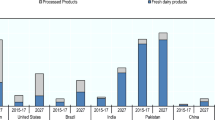Abstract
Economic values for production traits (milk yield, MY, g; 12-month live weight, yLW, kg; consumable meat percentage, CM, %) and functional traits (mature doe live weight, DoLW, kg; mature buck live weight, LWb, kg; kidding frequency, KF; pre-weaning survival rate, PrSR, %; post-weaning survival rate, PoSR,%; doe survival rate, DoSR, %; and residual feed intake, RFI, kg) were estimated using profit functions for the Small East African goat. The scenario evaluated was a fixed flock size, and the resultant economic values (Kes per doe per year) were 34.46 (MY), 62.35 (yLW), 40.69 (CM), 0.15 (DoLW), 2.84 (LWb), 8.69 (KF), 17.38 (PrSR), 16.60 (PoSR), 16.69 (DoSR) and −3.00 (RFI). Similarly, the economic values decreased by −14.7 % (MY), −2.7 % (yLW), −23.9 % (CM), −6.6 % (DoLW), −98 % (LWb), −8.6 % (KF), −8.2 % (PrSR), −8.9 % (PoSR), −8.1 % (DoSR) and 0 % (RFI) when they were risk rated. The economic values for production and functional traits, except RFI, were positive, which implies that genetic improvement of these traits would have a positive effect on the profitability in the pastoral production systems. The application of an Arrow-Pratt coefficient of absolute risk aversion (λ) at the level of 0.02 resulted in a decrease on the estimated economic values, implying that livestock keepers who were risk averse were willing to accept lower expected returns. The results indicate that there would be improvement in traits of economic importance, and, therefore, easy-to-manage genetic improvement programmes should be established.

Similar content being viewed by others
References
Campos, G.S., Neto, B.J., Oaigen, R.P., Cardoso, F.F., Cobuci, J.A., Kern, E.L., Campos, L.T., Bertoli, C.D., McManus, C.M., 2014. Bioeconomic model and selection indices in Aberdeen Angus cattle, Journal of Animal Breeding and Genetics, Article first published online on 20th January 2014, DOI: 10.1111/jbg.12069.
DAGRIS, 2013. Domestic Animal Genetic Resources Information System (DAGRIS). In: Kemp S, Mamo Y, Asrat Y, Dessie T (Eds.), International Livestock Research Institute, Addis Ababa, Ethiopia. Last retrieved from http://www.dagris.ilri.cgiar.org on 24th February, 2014.
Gunia, M., Mandonnet, N., Arquet, R., Alexandre, G., Gourdine, J-L. Naves, M., Angeon, V., Phocas, F., 2013. Economic values of body weight, reproduction and parasite resistance traits for a Creole goat breeding goal, Animal, 7, 22–33.
MoLD, 2012. Ministry of Livestock Development, Animal Production Division Annual Report for 2011, Nairobi, Kenya, 98 pp.
Okeno, T.O., Magothe, T.M., Kahi, A.K., Peters, K.J., 2012. Application of risk-rated profit model functions in estimation of economic values for indigenous chicken breeding, Tropical Animal Health and Production, 44, 1279–1287.
Renaudeau, D., Collin, A., Yahav, S., de Basilio, V., Gourdine, J.L., Collier, R.J., 2012. Adaptation to hot climate and strategies to alleviate heat stress in livestock production, Animal, 6, 707–728.
Republic of Kenya, 2013. Consumer price index and inflation rates. Kenya National Bureau of Statistics, Nairobi, Kenya. Last retrieved from http://www.knbs.or.ke/ on 24th February, 2014.
Sousa, W.H., Ojeda, M.D.B., Facó, O., Cartaxo, F.Q., 2011. Genetic improvement of goats in Brazil: experiences, challenges and needs, Small Ruminant Research, 98, 147–156.
Tolone, M., Riggio, V., Maizon, D.O., Portolano, B., 2011. Economic values for production and functional traits in Valle del Belice dairy sheep using profit functions, Small Ruminant Research, 97, 41–47.
Wolfová, M., Wolf, J., 2013. Strategies for defining traits when calculating economic values for livestock breeding: a review, Animal, 7, 1401–1413.
Acknowledgments
The fieldwork for this study was supported by joint funds from the Kenya Arid and Semi-Arid Lands (KASAL) programme through the Kenya Agricultural Research Institute and Kenya’s National Council for Science and Technology. We are also grateful to the German Academic Exchange Service (DAAD) for providing the first author with a sandwich scholarship in collaboration with Universität Kassel, Germany. Our gratitude is to the many pastoralists who shared with us their experiences and plight.
Conflict of interest
All authors declare that there are no actual or potential conflicts of interest among the authors and other people or organisations that could inappropriately bias their work.
Author information
Authors and Affiliations
Corresponding author
Rights and permissions
About this article
Cite this article
Mbuku, S., Kosgey, I., Okeyo, M. et al. Economic values for production and functional traits of Small East African goat using profit functions. Trop Anim Health Prod 46, 789–795 (2014). https://doi.org/10.1007/s11250-014-0567-8
Accepted:
Published:
Issue Date:
DOI: https://doi.org/10.1007/s11250-014-0567-8




